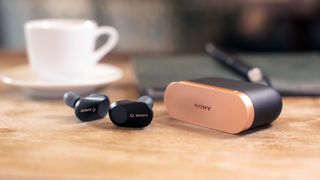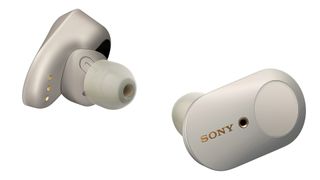Sony WF-1000XM3 review: true wireless headphones redefined with noise cancelling
They sound as good as Beats Powerbeats Pro but are more compact and add noise cancelling to boot


Joining the true wireless elite, Sony WF-1000XM3 sound stunning and cram in excellent noise cancelling as well – a real rival to AirPods and Powerbeats Pro
-
+
Amazingly good active noise cancelling (ANC)
-
+
Top notch audio performance
-
+
Handy 'Quick attention' mode
-
-
Not for workout use
-
-
ANC more effective on the ground than on planes
Why you can trust T3

The WF-1000XM3 are eagerly awaited new latest addition to Sony’s class-leading 1000X family of noise cancelling headphones, whose daddy is the WH1000XM3, with the M3 signalling that they are the third version of Sony's over-ear flagship. However, pay attention now: the WF-1000XM3 is a pair of true wireless buds with noise cancelling and the successor to the WF-1000X. There was no WF-1000XM2. I know right?
Sony is certainly no stranger to noise cancelling cans, but really got game with the launch of its 1000X series back in 2016, when it managed to turn noise cancelling from science into something more like art. The WH-1000XM3, as you’ll know if you've been paying attention, were deemed Best Noise Cancelling headphones in this year’s T3 Awards.
Well the WF-1000XM3 use almost the same third-gen noise cancelling processor, the QN1, as found in that award-winning model. There's one processor in each earbud, to handle noise suppression, digital to analogue conversion and analogue amplification. As a feat of engineering they’re impressive. They also sound ludicrously good.
So whether you see this as a downsized WH-1000XM3 or a long-overdue successor to the WF-1000X, the WF-1000XM3 is a big deal.
Sony WF-1000XM3: build quality and design

Maybe a little on the chunky side, but then WF-1000XM3 have a lot packed in
Sony’s WF1000XM3 buds – the WF stands for 'Wireless Freedom', of course – ship in a reasonably smart rechargeable case. Locked in place by magnets, they can be recharged out in the wild as the case itself doubles as a battery pack. Straight away this seems an improvement over the original WF1000X.
Available in classic black or not-so-classic 'champagne' silver livery, they’re much bigger than an Airpods case, but that is not really the same kind of product. It's not as bulky as Sennheiser’s Momentum True Wireless active noise cancellers – arguably their closest competitor – and it's absolutely tiny compared to the suitcase the Beats' Powerbeats Pro come in.
There’s Bluetooth NFC for quick Android pairing, Google Assistant support, plus Sony’s proprietary DSEE HX sonic 'upscaler', which is intended to 'restore' audio quality lost on compressed MP3s and streams.
Via the Sony Headphones Connect app you can make subtle EQ changes, or prioritise Bluetooth connection over sound quality – not advised.
As with Powerbeats and Airpods, a simple proximity sensor provides wearing detection; the WF-1000XM3 knows when they’re on duty. Pop one out and your music will pause, only to resume when you put it back in place. There’s also a Quick Attention mode available on the right-hand ear bud – press to allow through ambient sound such as someone talking to you, or travel announcements. There's also 'adaptive sound control' which tries to understand your environment and reduce or increase noise cancelling accordingly.
The headphones support hands-free voice calling, either using both earbuds or a single left or right one.
Sony WF-1000XM3: sound and noise cancelling

The Sony WF-1000XM3 fits really well, sealing out noise. Then advanced processing really seals out noise
When it comes to musicality, the WF-1000XM3 don’t disappoint. They’re spatially precise, with a great mid-range for speech and vocals, and an ability to drop low when required, without sounding boomy. The WF-1000XM3 can also handle trickier sounds such as horns with unapologetic bravado and a minimum of honkiness, while vocals soar gloriously high.
The Sony’s can also kick ass. The industrial metal of Rammstein’s Ich Will really rumbles, and they’re marvellously dynamic. Given how diminutive the drivers are, the sound is huge.
The WF-1000XM3’s noise cancelling is similarly impressive. It copes with train and bus noise extremely well, and made a reasonable job of combating cabin noise on a 900 mile flight from Budapest. If you’re looking for solace during the morning commute, these True Wireless buds are clinically efficient – unless you commute by aeroplane, because in truth, they struggled to suppress the incessant drone within the aircraft cabin. Go for a pair of Sony over-ear WH-1000XM3 instead, if you're a frequent flyer.
If you want to get technical, the WF-1000XM3 use a 24-bit audio processor, while the silicon in the WH-1000XM3 is 32-bit, so this may well explain the discrepancy. With no aptX HD or LDAC on board Sony's true wireless buds are also, unlike their larger brother, not HD compatible but really, so what? AAC and SBC are supported and latency seems way lower than the original WF1000X so I rather assumed they also use aptX low latency but as it turns out they don’t. That’s why you should always actually read the spec sheets on these things.
For noise cancelling to work with this style of headphone, fit is all-important. It helps to be confident they’re not going to fall out at an inopportune time. So Sony has engineered a clever ‘in and twist’ mechanism that locks the earbuds between your Tragus, Antitragus and Antihelix – these are parts of your ear, and not Norse gods as you may have thought.
The fit is snug and also reasonably comfortable. A variety of non-slip rubber earbud covers are supplied in the box for those with non-standard lugholes. However, the fit can't be compared to gym-friendly true wireless buds such as Jabra Elite 65t, Bose Free or, above all, Powerbeats Pro, which would remain stable in a severe earthquake. When walking around, we felt a bit of movement – nothing drastic or experience-ruining, but it was there.
Unlike the first-gen WF-1000X, Bluetooth stability is excellent, and I've experienced no connection hiccups so far. As on the Bose SoundSport Free, the antenna is in the protruding part of the headphone, to minimise interference caused by your head.
Like Powerbeats Pro, these use L/R simultaneous Bluetooth transmission, which is a slightly different approach to the more common L-R Relay BT transmission system, where there is only one single primary BT connection with the playback device. This gives greater signal stability and, Sony says, '75 per cent less latency'.
More importantly, it means lower power consumption, and partly as a result, battery life is well above what you'd have got from true wireless buds a year ago. The WF-1000XM3 will noise cancel for the best part of six hours, while the case holds enough juice for an additional 18 hours. Turn off the NC and you'll get 8 hours of playback (32 with in-case recharging). That's up there with Powerbeats Pro. You will also get 90 minutes more play from just 10 minutes of charging, which is potentially handy.
Sony WF1000XM3 review: verdict

With these Sonys and the work of a few other brands, notably Beats by Dre, true wireless have come of age
The Sony WF-1000XM3 combine excellent audio performance by true wireless standards, with Sony’s class-leading noise cancelling technology. They also offer solid battery life, and although they are a little bulbous, you won’t look like you’re wearing them for a laugh.
As I said, the noise cancellation won't quell flight noise like a good pair of over ears will. And they’re not sweat proof or IP-rated, so gym-goers and runners should look to Beats Powerbeats Pro or Jabra Elite Active 65t.
Anyone else wanting a great pair of True Wireless headphones with active noise cancelling for everyday use, which sound superb without costing silly money, should seriously consider the WF-1000XM3.
They sound about as good as the other two really good-sounding true wireless buds – Sennheiser's Momentum True Wireless and the Powerbeats Pro – but go on sale at £30-£40 less than the former and are more portable than the latter, and have noise cancelling. That makes them a formidably good option.
If you are a gym goer or value really unshakeable fit, we'd still recommend the Beats Powerbeats Pro as the best true wireless option. For pure sound quality in a wider range of environments (thanks to the noise cancelling), WF-1000XM3 are an even better bet. Apple AirPods remain top choice if you just want to sling buds in your ears and wear them all day.
Sign up to the T3 newsletter for smarter living straight to your inbox
Get all the latest news, reviews, deals and buying guides on gorgeous tech, home and active products from the T3 experts
For over 25 years, Steve has been casting his keen eyes and ears over the best that the world of TV and audio has to offer. He was the creator of Home Cinema Choice magazine, and contributes to huge range of technology, home and music titles along with T3, including TechRadar, Louder, Ideal Home, the i newspaper, and more.
-
 Forget the Samsung Galaxy S25 Edge, the "world's thinnest" phone could be coming from a different source
Forget the Samsung Galaxy S25 Edge, the "world's thinnest" phone could be coming from a different sourceBut it's not clear when or even if it might launch
By Britta O'Boyle Published
-
 Cuisinart’s new barbecue is a grill, griddle and pizza oven in one – but it’s the price you’ll love
Cuisinart’s new barbecue is a grill, griddle and pizza oven in one – but it’s the price you’ll loveCuisinart debuts two new grills and they’re incredible value for money
By Bethan Girdler-Maslen Published
-
 Infinix Zero concept shows how flip phones can be even more pocket-friendly
Infinix Zero concept shows how flip phones can be even more pocket-friendlyYour next folding phone could be even smaller
By Chris Hall Published